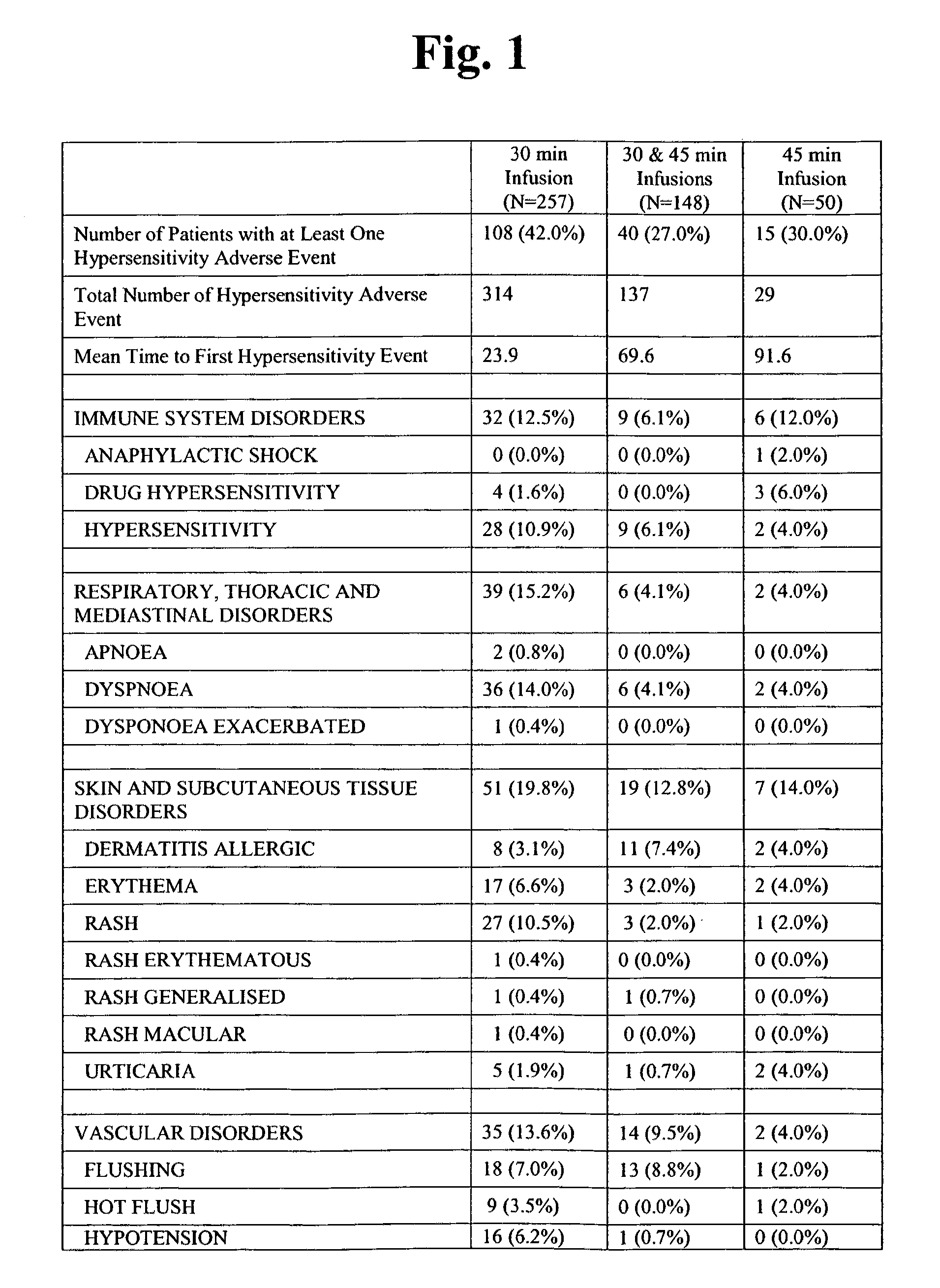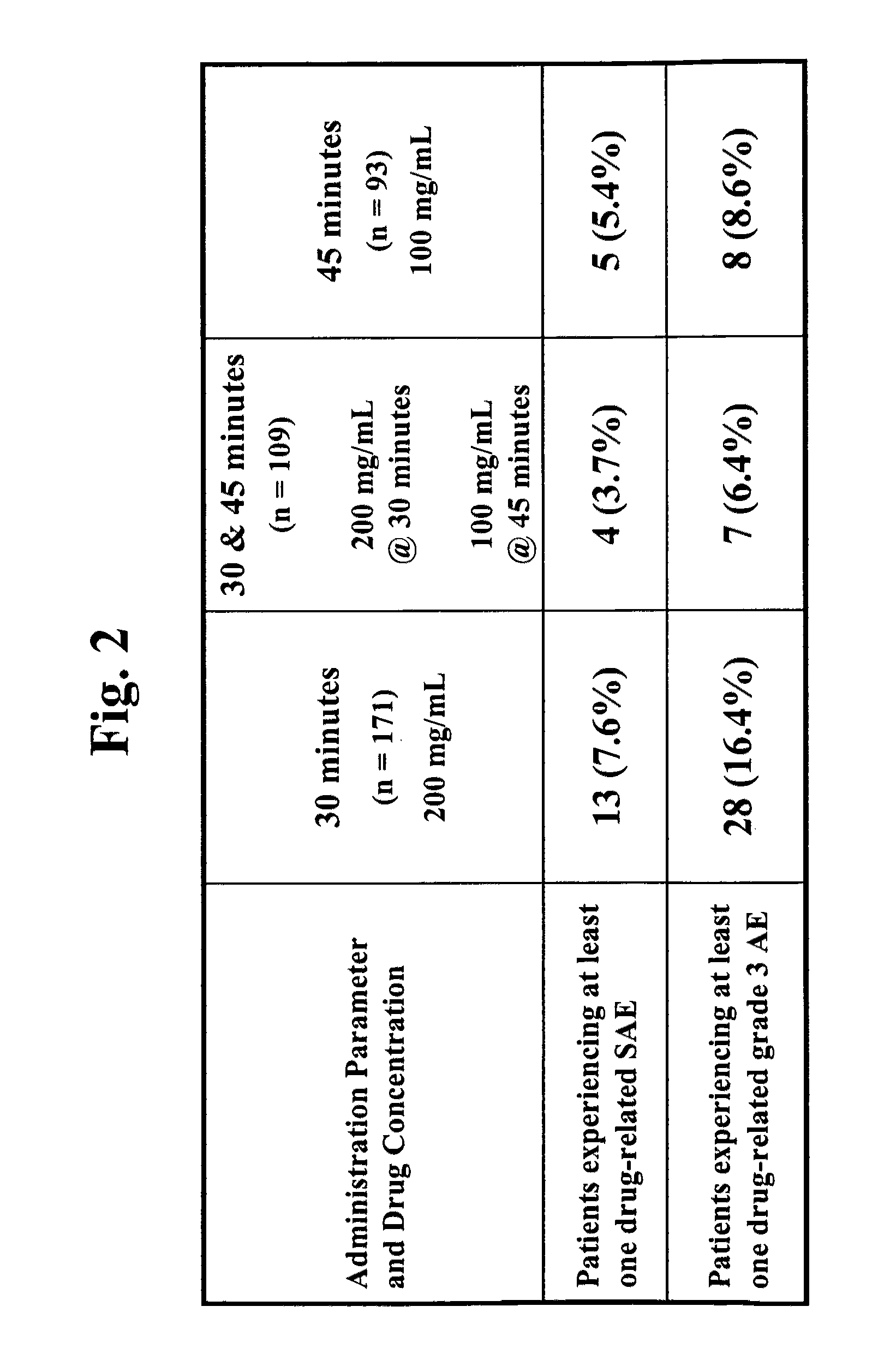Chemoprotective methods
a technology of chemoprotective methods and active ingredients, applied in the direction of antinoxious agents, drug compositions, phosphorous compound active ingredients, etc., can solve the problems of limiting materially compensating or limiting the potential benefits of the patient undergoing treatment, limiting or curtailing the effectiveness of the primary treatment of the patient's cancer, and even preventing it all together. , to achieve the effect of reducing the level o
- Summary
- Abstract
- Description
- Claims
- Application Information
AI Technical Summary
Benefits of technology
Problems solved by technology
Method used
Image
Examples
example 1
Preparation of Disodium 2,2′-dithio-bis-ethane Sulfonate Solution for Administration
[0186]Sterile de-pyrogenated, disodium 2,2′-dithio-bis-ethane sulfonate that has been manufactured for parenteral administration to subjects, can be prepared for administration as follows.
[0187]All facilities and equipment are verified to be suitable for use in making pharmaceutical preparations (hereinafter “the preparation room”). After the facilities are verified to be suitably sterile, and has acceptable endotoxin, impurity, and contaminant levels, the solution from Example 1 is transferred to the preparation room. The preparation room is continuously monitored for airborne particles and viable flora as well as pressure differential compared to the pressure outside the preparation room. A heat belt is applied to a sterile vessel, of the appropriate size, containing the 2,2′-dithio-bis-ethane sulfonate composition (i.e., disodium 2,2′-dithio-bis-ethane sulfonate, and / or another pharmaceutically-ac...
example 2
Administration of a Disodium 2,2′-dithio-bis-ethane Sulfonate Solution
[0191]In the event it is further desired to administer a disodium 2,2′-dithio-bis-ethane sulfonate solution to the same or a different patient from the immediately preceding Example 1, that has a final osmolarity of about 830 mOsm / L and to administer said solution to the patient at the same dose rate, the adjustment in the osmolarity of the preparation of the disodium 2,2′-dithio-bis-ethane sulfonate solution and the administration of the same prepared solution may be as follows: (i) 156.4 mL of a 20% (200 mg / mL) disodium 2,2′-dithio-bis-ethane sulfonate solution would be added to 156.4 mL of water dextrose in water, physiological saline solution, dextrose and saline solution, or any other acceptable sterile diluent that is approved for use in parenteral administration, and placed in a suitable plastic or class container for said administration; (ii) the rate of the disodium 2,2′-dithio-bis-ethane sulfonate soluti...
example 3
Administration of a Disodium 2,2′-dithio-bis-ethane Sulfonate Solution at a 100 mg / ml Concentration Over a 45 Minute Time Range
[0192]Administration of an appropriately prepared solution of 2,2′-dithio-bis-ethane sulfonate, e.g., disodium 2,2′-dithio-bis-ethane sulfonate (and / or another pharmaceutically-acceptable salt, prodrugs, analogs, conjugates, hydrates, solvates, and / or polymorphs, as well as stereoisomers (including diastereoisomers and enantiomers) and tautomers thereof)), approximately 830 mOsm / L in final form, is carried out under a properly executed physician's order. The subject is administered intravenously a 100 mg / mL disodium 2,2′-dithio-bis-ethane sulfonate solution at a rate of about 7 mL / minute for 45 minutes total.
PUM
| Property | Measurement | Unit |
|---|---|---|
| concentration | aaaaa | aaaaa |
| osmolarity | aaaaa | aaaaa |
| osmolarity | aaaaa | aaaaa |
Abstract
Description
Claims
Application Information
 Login to View More
Login to View More - R&D
- Intellectual Property
- Life Sciences
- Materials
- Tech Scout
- Unparalleled Data Quality
- Higher Quality Content
- 60% Fewer Hallucinations
Browse by: Latest US Patents, China's latest patents, Technical Efficacy Thesaurus, Application Domain, Technology Topic, Popular Technical Reports.
© 2025 PatSnap. All rights reserved.Legal|Privacy policy|Modern Slavery Act Transparency Statement|Sitemap|About US| Contact US: help@patsnap.com



